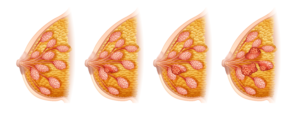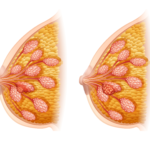Breast cancer and prostate cancer, the most common cancers in women and men, are influenced by genetic variants. Breast cancer is the most prevalent cancer diagnosis in females, and prostate cancer is the most prevalent cancer diagnosis in males. Genetic variants, along with several other factors, is a fascinating area of research.
Both breast cancer and prostate cancer are characterized by a high heritability, estimated to be around 31% for breast cancer and 58% for prostate cancer. It is noteworthy that in 17% of the patients with a family history of prostate cancer who were referred for genetic testing, a pathogenic germline variant could be identified. Breast cancer and prostate cancer share some susceptibility genes, suggesting a potential shared genetic predisposition between the cancer types. It has also been observed that a family history of first-degree relatives of prostate cancer increases women’s risk of developing breast cancer by 14%. Similarly, having a first-degree relative with breast cancer increases the chance of developing prostate cancer by 18%, which further underpins the hypothesis of shared genetic risk factors.
Cancer Mutations
Having a BRCA2 mutation differs from BRCA1 mutations and raises the risk of several types of cancer. At the current time, however, our knowledge is still growing, and this may change in time. These cancers are more common in people with BRCA2 mutations and include:
- Breast cancer: Breast cancer due to a BRCA mutation accounts for 20% to 25% of hereditary breast cancers. Women who have a BRCA2 mutation have a 45% chance of developing breast cancer by the age of 70 (slightly lower than with a BRCA1 mutation). Men with a BRCA1 mutation also have a 1% risk of breast cancer and a 6% risk with a BRCA2 mutation. Women and men with a BRCA mutation also tend to develop breast cancer at a younger age.9
- Ovarian cancer: Women who have a BRCA2 mutation have an 11% to 17% chance of developing ovarian cancer by the age of 70 (also somewhat lower than with a BRCA1 mutation). Women with a BRCA2 mutation tend to develop ovarian cancer at a younger age than women without the mutation.10
- Prostate cancer: Men with both BRCA1 and BRCA2 mutations are 4.5 to 8.3 times more likely to develop prostate cancer. Those with BRCA2 mutations (unlike BRCA1) often develop aggressive prostate cancer, and the 5-year survival rate is around 50%(compared to a 99% 5-year survival rate in the general population).
Male Breast Cancer
There is a pressing need for more research to unravel the distinct characteristics of male and female breast cancers. While current treatments are often uniform, ongoing research is revealing unique genetic variations that impact men, hinting at a different biological nature of breast cancer in men compared to women.
Men’s breast tissue contains ducts like women’s, but it typically lacks lobules responsible for milk production.
It’s important to note that most breast cancer, including in men, originates in the milk ducts or the glands, even though they’re typically non-functional in men. Other types of breast cancers that begin in other breast cells are less common.
Breast Cancer Types in Men
Breast cancer types are separated into two main groups: invasive or in situ (non-invasive). All kinds of breast cancer fall under one of these categories.
- In situ (non-invasive): When breast cancer is not invasive, it’s most likely ductal carcinoma in situ (DCIS), a non-invasive type of breast cancer that starts in a duct and has not yet spread anywhere else.
- Invasive: Invasive breast cancer refers to any breast cancer that spreads from the original site and “invades” other areas, like nearby breast tissue, lymph nodes, or anywhere else in the body.
About 80 percent of all male breast cancers are what’s called invasive ductal carcinoma (IDC). IDC is a cancer that starts in a duct and grows into other parts of the breast.
Men can have several different types of breast cancer. While still rare, the most common types include:
- Ductal carcinoma in situ (cancerous or precancerous cells that have not spread)
- Invasive (infiltrating) ductal carcinoma (cancer starts in a duct and spreads, forming a tumor)
- Inflammatory breast cancer (cancer spreads through tissue layers in the breast but does not form a lump)
- Paget’s disease of the nipple (cancer starts in a duct and spreads to the nipple and sometimes the areola)
- Invasive lobular carcinoma (another type of breast cancer seen in women that is rare in men)
- Other subtypes of carcinomas in the male breast are possible but extremely rare.
Symptoms of Male Breast Cancer
Signs and symptoms of male breast cancer can include:
- A painless lump or thickening of the skin on the chest.
- Changes to the skin covering the chest, such as dimpling, puckering, scaling, or changes in the skin color.
- Changes to the nipple, such as skin color or scaling, or a nipple that begins to turn inward.
- Discharge or bleeding from the nipple.
Symptoms of Prostate Cancer
Prostate cancer may not cause symptoms at first. Most prostate cancers are found at an early stage. This means that the cancer is only in the prostate. Early-stage prostate cancer often doesn’t cause symptoms.
When they happen, early-stage prostate cancer signs and symptoms can include:
- Blood in the urine, which might make the urine look pink, red, or cola-colored.
- Blood in the semen.
- Needing to urinate more often.
- Trouble getting started when trying to urinate.
- Waking up to urinate more often at night.
If the prostate cancer spreads, other symptoms can happen. Prostate cancer that spreads to different parts of the body is called metastatic prostate cancer. It also might be called stage 4 prostate cancer or advanced prostate cancer.
Signs and symptoms of advanced prostate cancer can include:
- Accidental leaking of urine.
- Back pain.
- Bone pain.
- Difficulty getting an erection, called erectile dysfunction.
- Feeling very tired.
- Losing weight without trying.
SUMMARY
Get Screened
Prostate cancer is a significant indicator of an inherited mutation. The expert guidelines strongly advocate genetic counseling and testing for individuals with prostate cancer. With a BRCA2 mutation, there is an increased risk for male breast, pancreatic, and prostate cancer. It’s crucial to not only focus on cancer history from the mother’s side but also the father’s side. It’s a shared responsibility to understand our family’s health history.
Prostate cancer, the most prevalent invasive cancer among men in the United States, underscores the crucial need for early screening. The National Comprehensive Cancer Network advises male BRCA2 mutation carriers to commence prostate cancer screening with prostate-specific antigen (PSA) testing and a digital rectal exam by age 40. Similarly, BRCA1 mutation carriers are encouraged to consider testing at this age.
Men are advised to engage in a dialogue with their healthcare providers to determine the suitability of prostate cancer screening. This professional guidance is crucial in making informed decisions about their health.
It’s vital to inform your doctor if your immediate family members, such as your mother, father, sister, brother, or children, have been diagnosed with breast or prostate cancer. Sharing this information with your family can help everyone accurately assess their cancer risk and guide personalized screening recommendations.
References
BrownHealth.org
City of Hope
Mayo Clinic
Science Direct
The Conversation
VeryWell Health










